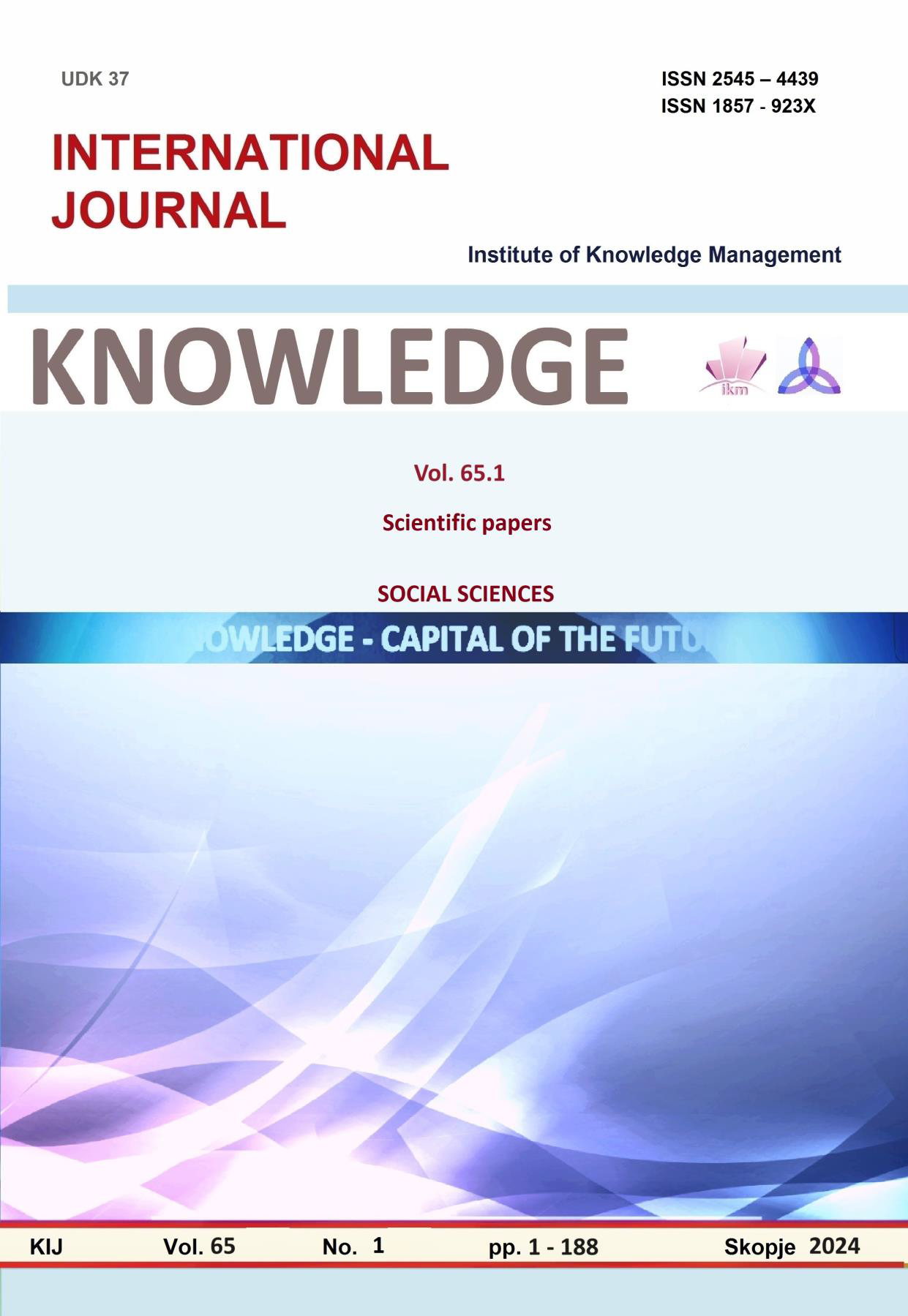EMOTIONAL INTELLIGENCE BUILDING LEADERSHIP PERSPECTIVES IN THE EDUCATIONAL SECTOR
Keywords:
leadership, style, emotional intelligence, practice, organizationAbstract
Education serves as the cornerstone of society, facilitating its growth and prosperity. Consequently, understanding how leadership perspectives are shaped becomes crucial. Scholars have long been fascinated by uncovering the interconnections among leadership, organizational culture, and emotional intelligence, a discussion spearheaded by Goleman. However, the persistence of traditional educational paradigms poses an additional challenge. Thus, the focus of this manuscript shifts towards leveraging empirical data to explore specific leadership styles in relation to emotional intelligence within a distinct context. Drawing insights from 110 respondents, this research utilizes a questionnaire designed with validated research instruments. Findings reveal a strong correlation between emotional intelligence and leadership styles, particularly highlighting a pronounced inclination towards transformational leadership. Notably, within the educational sector, commanding leadership emerges as the most prevalent style, followed by visionary leadership. Empathy, a key emotional intelligence competence, exhibits the lowest correlation with commanding style but the highest with affiliative leadership. Additionally, the research reveals that emotional self-control is the least developed emotional intelligence skill among educational professionals in the Republic of North Macedonia, indicating a vital area requiring enhancement and growth. This study reaffirms the interdependent relationship between leadership and emotional intelligence within organizational settings.
References
Ameriks, J., Wranik, T., Salovey, P., (2009). Emotional Intelligence and Investor Behavior. Research foundation of CFA institute. ISBN 978-1-934667-22-4.
Asgari, A., Mezginejad, S., & Taherpour, F. (2020). The Role of Leadership Styles in Organizational Citizenship Behavior through the Mediation of Perceived organizational Support and Job satisfaction. Innovar: Revista de Ciencias Administrativas y Sociales, 30(75), 87–98. https://www.jstor.org/stable/26863971 Bass, B. M. & Stogdill, R.M., (1990) Bass & Stogdill’s Handbook of Leadership, 3rd ed. New York: The Free Press.
Bass, B. M. (1985). Leadership and performance beyond expectations. New York: The Free Press. Boyatzis, R. E., Goleman, D., & Rhee, K. S. (2000). Clustering competence in emotional intelligence: Insights from the Emotional Competence Inventory. In R. Bar-On & J. D. A. Parker (Eds.), The handbook of emotional intelligence: Theory, development, assessment, and application at home, school, and in the workplace. San Francisco: Wiley. British Ministry of Defence. (2021). Army leadership doctrine. AC 72029. Camberley Surrey: Centre for Army leadership.
Goleman, D., Boyatzis, R., & McKee, A. (2002). Primal leadership: Realizing the power of emotional intelligence. Harvard Business School Press. Hambrick, D.C. (2007), “Upper echelons theory: An update”. Academy of Management Review. Huczynski, A.A., Buchanan, D.A., (2013). Organizational Behavior. Harlow: Pearson education.
Olawoyin, R. (2018). EMOTIONAL INTELLIGENCE: Assessing Its Importance in Safety Leadership. Professional Safety, 63(8), 41–47. https://www.jstor.org/stable/48690086
PÎRVU, Cătălin. “EMOTIONAL INTELLIGENCE – A CATALYST FOR SUSTAINABILITY IN MODERN BUSINESS.” Theoretical and Empirical Researches in Urban Management 15, no. 4 (2020): 60–69. https://www.jstor.org/stable/26955975.
PORRAS-CRUZ, L.-T., & BUITRAGO-BONILLA, R.-E. (2024). El manejo emocional en maestros, un análisis desde la experiencia - Emotional management in teachers, an analysis from experience. Revista Española de Pedagogía, 82(288), 291–310. https://www.jstor.org/stable/48773925
Raven. B. J. (1993). “The Bases of Power: Origins and Recent Developments,” Washington DC: JSI.
Robbins, S. P., & Judge, T. (2013). Organizational behavior. Upper Saddle River, NJ: Prentice Hall Rothaermel. F.T. (2017). Strategic Management. New York: McGraw-Hill Education. Rumelt, R. (2011). Good Strategy, Bad Strategy: The Difference and Why It Matters. NY: Crown Business;
S. Côté, P. N. Lopez, P. Salovey, and C. T. H. Miners. (2010). “Emotional Intelligence and Leadership Emergence in Small Groups,”. Leadership Quarterly 21. Sayeed, O. B., & Shanker, M. (2009). Emotionally Intelligent Managers & Transformational Leadership Styles. Indian Journal of Industrial Relations, 44(4), 593–610. http://www.jstor.org/stable/27768233.
Schein, E. (2004). Organizational culture and leadership. San Francisco: Jossey-bass.
Schein. E. H. (1983). The Role of the Founder in Creating Organizational Culture,” Organizational Dynamics, pp. 13–28.
Schein. E. H. (1996). “Leadership and Organizational Culture,” in F. Hesselbein, M. Goldsmith, and R. Beckhard (eds.) (1996).The Leader of the Future. San Francisco: Jossey-Bass.
Shin. S. J. and Zhou. J. (2003). “Transformational Leadership, Conservation, and Creativity: Evidence from Korea,” Academy of Management Journal .
Stogdill, R.M. (1948). "Personal Factors Associated with Leadership: A Survey of the Literature," Journal of Psychology, 25, 64.
Van Velsor, E., & Leslie, J. B. (1995). Why executives derail: Perspective across time and cultures. Academy of Management Executive, 9 (4), 62–72.
Walumbwa, F. O., Avolio, B. J., Gardner, W. L., Wernsing, T. S., & Peterson, S. (2008). Authentic leadership: development and validation of a theory-based measure. Journal of Management, 34(1).
Warrick, D. D. (2017). “What leaders need to know about organization culture”. Business Horizons, Amsterdam: Elsevier.
Wolff, S. B. (2005). Emotional competence inventory 2.0. HayGroup. McClelland Center of Research and innovation. 0511-9889-HAYG. Wootton, S., and Horne, T. (2003). Strategic Thinking: A nine step approach to strategy and leadership for managers and marketers. London: Kogan page. Yukl, G. (2010). Leadership in Organizations, 7th ed. Englewood Cliffs, NJ: Prentice Hall.
Zacher, C. (2022). CORPORATE LIFE: EMOTIONAL INTELLIGENCE FOR EMERGING LEADERS. US Black Engineer and Information Technology, 46(1), 16–19. https://www.jstor.org/stable/48697626





